
December 2015
General Strikes Are Back in
Greece:
Revolutionary Leadership Needed
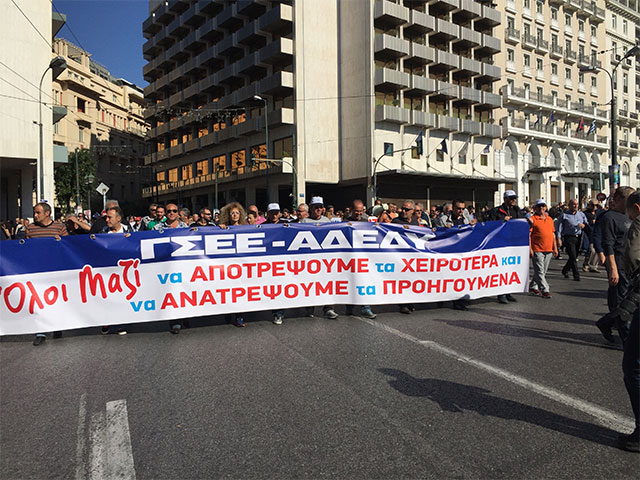
Contingent of GSEE (General Confederation of Greek Workers) and ADEDY (government employees federation) during November 12 general strike in Athens: “Together to Prevent Worse, and to Overthrow the Previous.” (Internationalist photo)
After the populist SYRIZA (Coalition of the Radical Left) came into office last January, the Greek working class held off from mass protest in hopes that Prime Minister Alexis Tsipras would carry out election promises to end the punishing austerity program imposed by European central bankers and the International Monetary Fund. When Tsipras did an abrupt about-face in July and imposed the brutal austerity policies demanded by the imperialist financiers, there were big labor protests, but then a return to quiescence. Two months later, Tsipras was able to win a new mandate in snap elections on September 20 despite anger over his dramatic U-turn.1 But this fall, Greek workers returned to the streets.
On November 12, the first “general strike” under the SYRIZA government brought out tens of thousands of marchers in Athens and other major cities, shutting industry, transport and much of commerce. A few days later, a November 17 march on the U.S. embassy commemorating the 1973 student uprising that was brutally attacked by the Washington-backed military junta was also quite large. This was followed by regional transit strikes, a farmers protest against tax hikes, student sit-ins against repression, a work stoppage by ambulance workers, a two-day walkout by hospital workers and on December 3, a second, somewhat smaller, one-day national strike to protest further pension cuts agreed to by Tsipras & Co.
Many labor officials and activists had worried what the response would be to the November 12 strike call. Coming not long after Tsipras won the September elections despite imposing hated austerity measures, the large turnout shows that the willingness to struggle of the Greek working people is unbroken. As result, the Greek left almost unanimously proclaimed the strike a success or “big success.” Yet while strike action and mass protests are back, this is still a far cry from the situation of 2010-11 when hundreds of thousands struck and marched. Above all, there is no strategy for a fight for power, in a situation in which the Eurobankers have driven home what has been obvious for years, that no amount of pressure will produce an end to austerity under capitalism. The crisis of revolutionary leadership is as acute as ever.
The Internationalist had a team in Greece reporting on the November strike and events in the following days. Here is their report:
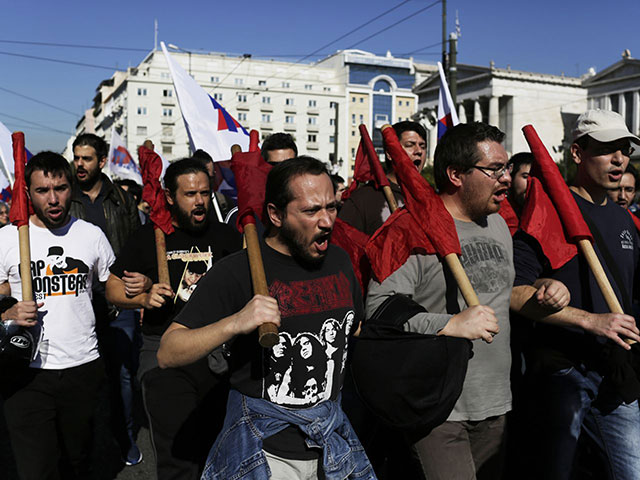
Contingent of PAME (All Workers Militant Front) linked to the Communist Party in November 12 general strike in Athens. (Petros Giannakouris/AP)
ATHENS, Greece – November 12 saw the first general strike here since SYRIZA took office early this year in coalition with the right-wing populist Greek Democrats (ANEL). Some 30,000 marched through the streets of Athens, 10,000 were reported in Thessaloniki in the north, and thousands more in the port city of Piraeus, at Patra in the Peloponnesus, Volos in the east and elsewhere around the country. The turnout among public workers in particular was solid. Transport of all types – from the Athens subways and buses to rail, domestic air flights and the ferries from the Greek mainland to the islands – was severely disrupted. Public schools and universities were shut down and hospitals had only emergency service. The strike was effective in all of the ports.
The preceding week was filled rolling labor struggles. On Monday November 1, the seamen’s union PNO decreed a two-day strike of ferries to the Aegean islands. Also on Monday, the OLME teachers union walked out while high school students protested over shortages in gthe schools. On Tuesday, workers at two main Athens hospitals walked out, followed by subway, streetcar and electric railway workers in the evening.. On Wednesday the ferry strike was renewed for another 48 hours. On Thursday, pensioners rallied in central Athens. On Friday, November 6 the seamen’s strike was called off, reportedly due to pressure from the PAME labor federation linked to the Communist Party (KKE).
The November 12 strike was against the austerity policies imposed by the European Union. You can’t exactly say the strike was against the left/right bourgeois government led by Tsipras, as SYRIZA’s labor department called on workers to join it! And one even has to put the words “general strike” in quotation marks, because what this denotes in Greece (and Europe generally) these days is a one-day work stoppage combined with mass demonstrations. For Marxists, a real general strike is a frontal clash between the workers movement and the capitalist government – one step below an insurrection on the scale of revolutionary tactics. Nevertheless, the substantial turnout showed that the SYRIZA spell is wearing off.
The spectacle of a government party backing a strike against the policies it is implementing may be a first. The Greek right-wing parties and European finance ministers howled, denouncing SYRIZA for wanting to “have its cake and eat it too.” But then the double-talking Tsipras last July pulled a fast one, calling a referendum and urging Greek voters to say “OXI” (NO) to the EU’s austerity demands, almost all of which he had already agreed to, and then when 60% voted “no,” he turned around and agreed to worse austerity. The purpose was to absolve SYRIZA of responsibility for its crime. While the bulk of the left went along with this pantomine, the League for the Fourth International warned that even a “no” vote would lead to more austerity.
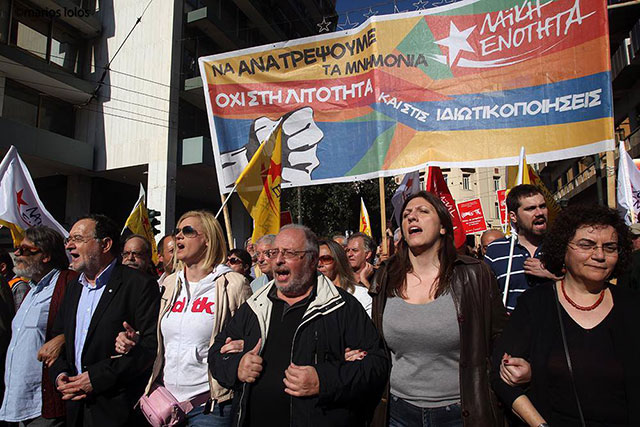
Contingent of Popular Unity (LEA, Laďki Enótita, former Left Platform of SYRIZA) in November 12 general strike. LEA leader and former development minister Panagiotis Lafazanis, second from left, and former Greek parliament president Zoe Konstantopoulou, third from right). (NPA)
The strike was called by the GSEE (the General Federation of Greek Workers) and ADEDY, the government employees’ federation. Giorgios Kalomoiris, a leader of ADEDY, told the press, “The winter is going to be explosive and this will mark the beginning.” Kalomoiris is a supporter of LEA (Popular Unity), the former Left Platform of SYRIZA that split off in the summer (after its ministers were sacked) yearning for the “good old days” of the pre-2015 SYRIZA. The GSEE leadership includes supporters of the populist-nationalist PASOK and even the right-wing New Democracy, the bourgeois duopoly that governed Greece for four decades. That fact that the various sellout bureaucrats organized even a one-day protest strike was a sign of desperation and a need to respond to pressure from the ranks.
In many respects the November 12 strike followed the pattern of preceding general strikes since the onset of the Greek financial crisis – by one count there were already no less than 40 since 2010. When the GSEE/ADEDY called a strike, the PAME, the trade-union federation close to the KKE (Communist Party), called its own separate event. The PAME march moved out from Omonia Square a half-hour before the GSEE/ADEDY march left Klafmonos Square, and was then joined by a feeder march of the ostensible far left coming from the Archaeological Museum. So the PAME marched past the Parliament building in Syntagma Square in one direction somewhat before the other march arrived and went by Parliament in the other direction.
The anarchist attacks which helped precipitate the end of the GSEE/ADEDY rally also had a rather ritualistic character, lobbing some Molotov cocktails at the cops from the cover of some far-left contingents (including some anarcho-syndicalists) inducing the cops to teargas everyone in the vicinity, including us. The anarchists went on to set fires in dumpsters and trash cans, hurled some more Molotovs against the doors of various banks and chipped away at their marble steps, which was quite symbolic of the futility of their actions. The press then had its photos of flames and charging riot police and its headlines about “clashes break out at general strike.” No. 41, going on 42.
The PAME march, which included high school students with
handmade banners and a student contingent, was definitely the
larger, with 15,000-plus marchers compared to 10,000-plus for
the GSEE/ADEDY/far left contingent, and gave a quite militant
appearance. The next day, the KKE denounced the “hollow
anti-Memorandum rhetoric” of its rivals, and rightly so. But
while it has kept its distance from SYRIZA and called the July
referendum a fraud, the KKE is itself only seeking to pressure
parliament. Rather than calling for workers action to smash
austerity, including measures already passed, PAME posters
focused on issues pending a vote by parliament: “Don’t gut
social security, No foreclosures by the bankers, Lower taxes.”
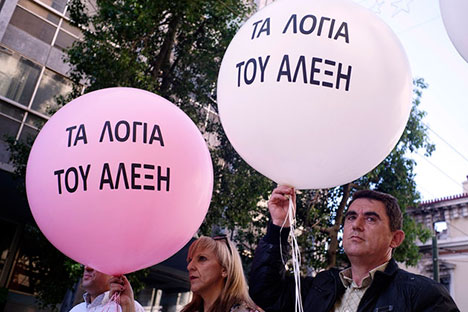 Balloons
In Athens general strike march: “Alexis’ Promises.” Nothing
but hot air. (Milos
Bicanski/Getty Images)
Balloons
In Athens general strike march: “Alexis’ Promises.” Nothing
but hot air. (Milos
Bicanski/Getty Images) Over at the GSEE/ADEDY march it was striking that virtually none of the banners attacked the government directly. At most there were some pink balloons with the words “Alexis’ Promises,” implying that they were so much hot air. SYRIZA could endorse the strike because it was just intended to blow off steam. Even most of the banners at the “far left” contingent focused on European Union dictates imposing austerity measures to Greece. The LAE opposed memoranda and “austerity and privatizations” in the abstract. The OKDE-Spartakos2attacked the memoranda and the “new and old minions” of the EU – its maximum demands were the cancellation of the debt and the exit of a (capitalist) Greece from the Eurozone and the EU.
ANTARSYA (Front of the Anti-Capitalist Left), a coalition of allegedly far-left parties that tried desperately to join up with the ex-ministers of the LEA before the September elections, did call to “defeat the government,” but what was to be “overthrown” was “EU-Capital.” Another ANTARSYA banner said, “Let the capitalists pay for the crisis.” I.e., increase taxes on big business rather than calling to bring down the bourgeois government and expropriate the capitalists. All of this fits in with a policy of amnestying SYRIZA by pretending that at its worst it was just capitulating to the Eurobankers. Before the strike, an ANTARSYA spokesman declared bombastically, “our rage will be relentless”. But not too relentless, it seems.
So SYRIZA tries to take the heat off by endorsing the strike while criticizing “neoliberal policies and economic blackmail,” as if it were some kind of alien observer, and the “far left” plays along. In an article on the November 12 strike, the editor of the newspaper of the SEK (Socialist Workers Party),3 Panos Garganas, proclaims it “the biggest strike demonstration since the huge strikes that brought down the government of technocrats in 2012” – even though those were far larger. Calling the prospect of a “real” left government advocated by the LAE “remote” (he’s right about that), Garganas argues that the strike showed that “workers’ own action can force the government to make a U-turn and stop implementing austerity.”
In this social-democratic fantasyland, the Eurobankers force Tsipras to make a U-turn (kolotoumba in Greek) to austerity, but workers’ pressure can force him to make a U-turn back! It’s all to deny that SYRIZA is a bourgeois (populist) party representing a section of the ruling class, and to delude people into thinking that pressure politics can get the bourgeoisie to abandon austerity policies which are vital to European capitalism’s survival. Yet Tsipras’ kolotoumba after the 60% OXI vote in July was the clearest possible demonstration that the bankers’ dictatorship will not be moved by protests or votes (see our article, “Greece: The Naked Rule of Finance Capital” (18 July), inThe Internationalist No. 41, September-October 2015).
Even the most left-wing contingent at the march, the ostensible Trotskyists of the EEK (Workers Revolutionary Party),4 pulled its punches about who was the enemy – its banner said “Down with the Memorandum and its Managers!” (Who might those be?) It went on to call for an “Unlimited General Political Strike” against austerity and “All Power to the Workers.” Only a few short months ago, the EEK was calling on SYRIZA to break with the bourgeoisie, i.e., with itself. Then, after Tispras’ about-face in July, the EEK ran a joint slate with ANTARSYA in the September elections on a supposed “transitional program” consisting of demands on the bourgeois government (ban layoffs, cancel the debt, nationalize the banks under workers control, exit the E.U., etc.) rather than a program leading to the overthrow of the capitalist state.
But is the unlimited or “indefinite” general strike proposed by the EEK an alternative? Merely setting no time limit is playing a passive waiting game – the old anarcho-syndicalist utopia. A genuine general strike involves constructing potential organs of dual power– elected and revocable strike committees, workers committees in the factories, workers councils in proletarian districts, the organization of workers self-defense. None of this is included in the “transitional” program of the EEK, or the various components of ANTARSYA, which are wedded to bourgeois electoralism. Above all, a genuine transitional program for socialist revolution requires a political mobilization under revolutionary, i.e., Trotskyist leadership.
There is much flammable material in crisis-ridden Greece. You see signs of acute social decay everywhere – the homeless, the addicts, the beggars. Eurostat figures for Greece show overall unemployment of 25%, the highest in the EU; youth unemployment over 50%; 39% of working-age population in poverty. Along with the permanent wage freeze exacerbated by huge tax hikes (value added tax of 23%) , the bankers are now demanding stepped-up foreclosures of homes of those behind on mortgage payments. They also threatens to decimate small businesses. Pharmacists and even some shopkeepers joined the general strike. But this is a volatile social layer, and if it does not see the working class as its rescuer, it could well turn to the fascists of Golden Dawn.
Many on the left have been wringing their hands over defeatism and resignation among the masses. If so, much of the responsibility lies with opportunist leftists, who “by seeing the populists in power as allies rather than representatives of the class enemy,” as we warned months ago, could only “demoralize the mass of the workers and poor” (see “Greece The SYRIZA Illusion Exploded” [March 2015], in The Internationalist No. 39, April-May 2015). But the Greek working class remains militant, as we saw on November 12. In Piraeus, even dock workers from the non-union container port owned by the Chinese shipping conglomerate Cosco marched in a contingent for the first time ever.
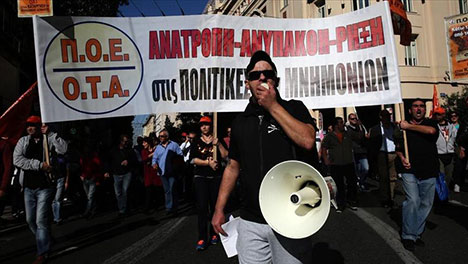 Contingent
of POE-OTA municipal workers union during general strike,
Athens, November 12. (Andalou
Agency)
Contingent
of POE-OTA municipal workers union during general strike,
Athens, November 12. (Andalou
Agency) Public employees are on the chopping block. At the GSEE/ADEDY march we spoke with a group of Athens municipal workers who have only temporary contracts and make barely half the previous minimum wage, meaning they have to live on around €400 (about US$435) a month. And these “pampered” public workers are supposed to be the “privileged” sector! While the bourgeois press pretends that private sector workers are hostile to general strikes, the solid shutdown of shipping, not to mention contingents such as the telephone workers of the privatized OTE (now owned by Deutsche Telekom) in the strike march, expose this as a lie.
An important development is taking place in the military under the impact of the refugee crisis. Almost 600,000 migrants from the Middle East have flowed through Greece this year. Now the same EU bosses who are impoverishing Greek workers are demanding that Greece “crack down” on immigrants by setting up concentration camps (“hot spots”) to house these desperate people fleeing imperialist bombing and Islamist terror, from Syria to Afghanistan. At the beginning of November, conscript soldiers from 50 different units signed a joint statement declaring “We don’t fight, we do not supress, we don’t hunt down migrants.” At the November 17 march on the U.S. embassy we met some of these leftist soldiers.
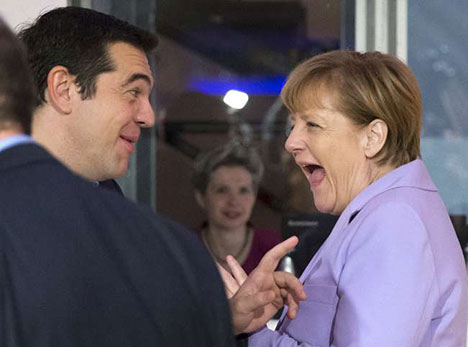 Alexis
Tsipras and German chancellor Angela Merkel having a good
laugh at conference in Malta on refugees during Greek general
strike, November 12.
(Alessandra Tarantino/AP)
Alexis
Tsipras and German chancellor Angela Merkel having a good
laugh at conference in Malta on refugees during Greek general
strike, November 12.
(Alessandra Tarantino/AP) They are part of Diktyo Spartakos (Spartacus Network), linked to the New Left Current (NAR), which is the largest component of ANTARSYA, but also including other “far left” groups, among them OKDE-Spartakos and anarchists. The draftees’ statement denounces the state’s “collaboration with the Nazi Golden Dawn”; that they are ordered to participate in “crowd suppression drills,” to prepare to repress “hungry-thirsty-imprisoned immigrants” such as on the island of Kos; and the Parmenionas 2015 exercise at the border fence separating Greece from Turkey, where several refugees have been gunned down by border police. Unlike many of the mealy mouthed banners on November 12, the soldiers directly denounce the Tsipras government:
“The SYRIZA-ANEL government continues the War on Terror, participates in imperialistic plans, targets ‘asymmetric threats’ (immigrants, social movements), playing on the false distinction of ‘good’ refugees from war – and ‘bad’ economic migrants. The Armed Forces call on us, the conscripted soldiers alongside professionals and officers, to make war on the ‘enemy within’…
“We refuse to convert the Greek army into a repressive apparatus whether that involves migrants or social movements…. We call on our colleagues to not only show compassion but to take note of our common class interests. It is the bourgeois institutions, bourgeois policies, bourgeois governments themselves which are destroying even our dreams.
“We are part of a modern anti-war and labour movement that can exist only within a working class, anti-capitalist and internationalist perspective. We resist, oppose, and totally reject the government, its imperialist mechanisms, and the bourgeois world of oppression.”

Syrian refugees arriving on island of Lesbos from Turkey, July 2015. Leftist Greek soldiers refuse to suppress or hunt down refugees. LFI calls for asylum for all refugees, full citizenship rights for all immigrants.
(Sergey Ponomarev for The New York Times)
The appearance of such class-conscious soldiers is a sure sign of the escalated radicalization among Greek workers and youth, reminiscent of developments in the U.S. Army when soldiers turned on officers as the imperialist war on Vietnam spiraled downwards to defeat in the late 1960s. But their demands are incompatible with capitalist rule. For this radicalization to lead anywhere except to defeat it is necessary to join it with a program for revolutionary struggle. We addressed this in an article last summer as the crisis was coming to a head:
“What’s needed, as the League for the Fourth International has repeatedly stated, is a revolutionary mobilization of the Greek working class, seizing banks, ports, airports, and key industries and imposing workers control, organizing workers defense guards to crush the Nazi-fascists of Golden Dawn and appeal to the ranks of the conscript army, and organizing workers councils with delegates recallable at any time. This would lay the basis for a new state power, a workers state, led by a Leninist-Trotskyist communist party built on the program of international socialist revolution.”
–“What Road for Greece: Perpetual Debt Peonage or Workers Revolution?” (12 August), in The Internationalist No. 41, September-October 2015
As a warehouse worker at the November 12 march bitterly remarked to us, what’s needed is a revolutionary left “in deeds and not just words.” Nowhere more than in Greece is this so excruciatingly clear. And that means, first and foremost, a Trotskyist nucleus fighting to build a genuinely Leninist communist party of the working class, a party that opposes class collaboration in every form and which is capable of being a “tribune of the people” championing all of the oppressed – first and foremost the immigrants and refugees. The many variants of opportunism have already been tried over the last five years, and all have failed to stop the money gougers who have ruined the lives of Greek working people.
With the euro or new drachma, a capitalist Greece inside our outside the imperialist European Union will only intensify the austerity. Revolutionary internationalists fight instead for a socialist federation of the Balkans and Europe-wide socialist revolution. ■
- 1.See “Greek Elections: For a Europe-Wide Workers Revolt Against Capitalist Austerity,”The Internationalist No. 41, September-October 2015.
- 2.Affiliated with the International Committee (formerly United Secretariat), followers of the late Ernest Mandel, which poses as the Fourth International. While the OKDE-Spartakos is part of ANTARSYA, its international ostentatiously supported SYRIZA, seeing it as the more successful opportunist coalition.
- 3.The SEK is also part of ANTARSYA and aligned with the British Socialist Workers Party, followers of the late Tony Cliff, who split from Trotskyism at the start of the anti-Soviet Cold War, calling the bureaucratically degenerated Soviet workers state “state capitalist” and refusing to defend it against imperialist attack in the Korean War.
- 4.The EEK is part of the Coordinating Committee for the Refoundation of the Fourth International led by Jorge Altamira’s Partido Obrero (Workers Party) in Argentina.
